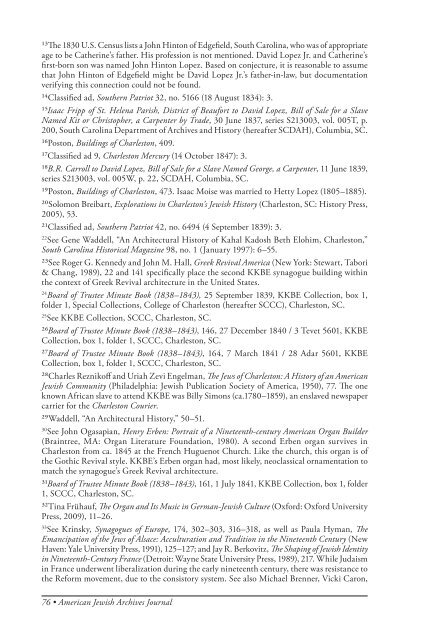American Jewish Archives Journal, Volume 64, Numbers 1 & 2
American Jewish Archives Journal, Volume 64, Numbers 1 & 2
American Jewish Archives Journal, Volume 64, Numbers 1 & 2
You also want an ePaper? Increase the reach of your titles
YUMPU automatically turns print PDFs into web optimized ePapers that Google loves.
13The 1830 U.S. Census lists a John Hinton of Edgefield, South Carolina, who was of appropriate<br />
age to be Catherine’s father. His profession is not mentioned. David Lopez Jr. and Catherine’s<br />
first-born son was named John Hinton Lopez. Based on conjecture, it is reasonable to assume<br />
that John Hinton of Edgefield might be David Lopez Jr.’s father-in-law, but documentation<br />
verifying this connection could not be found.<br />
14Classified ad, Southern Patriot 32, no. 5166 (18 August 1834): 3.<br />
15Isaac Fripp of St. Helena Parish, District of Beaufort to David Lopez, Bill of Sale for a Slave<br />
Named Kit or Christopher, a Carpenter by Trade, 30 June 1837, series S213003, vol. 005T, p.<br />
200, South Carolina Department of <strong>Archives</strong> and History (hereafter SCDAH), Columbia, SC.<br />
16Poston, Buildings of Charleston, 409.<br />
17Classified ad 9, Charleston Mercury (14 October 1847): 3.<br />
18B.R. Carroll to David Lopez, Bill of Sale for a Slave Named George, a Carpenter, 11 June 1839,<br />
series S213003, vol. 005W, p. 22, SCDAH, Columbia, SC.<br />
19Poston, Buildings of Charleston, 473. Isaac Moise was married to Hetty Lopez (1805–1885).<br />
20Solomon Breibart, Explorations in Charleston’s <strong>Jewish</strong> History (Charleston, SC: History Press,<br />
2005), 53.<br />
21Classified ad, Southern Patriot 42, no. <strong>64</strong>94 (4 September 1839): 3.<br />
22 See Gene Waddell, “An Architectural History of Kahal Kadosh Beth Elohim, Charleston,”<br />
South Carolina Historical Magazine 98, no. 1 (January 1997): 6–55.<br />
23See Roger G. Kennedy and John M. Hall, Greek Revival America (New York: Stewart, Tabori<br />
& Chang, 1989), 22 and 141 specifically place the second KKBE synagogue building within<br />
the context of Greek Revival architecture in the United States.<br />
24 Board of Trustee Minute Book (1838–1843), 25 September 1839, KKBE Collection, box 1,<br />
folder 1, Special Collections, College of Charleston (hereafter SCCC), Charleston, SC.<br />
25 See KKBE Collection, SCCC, Charleston, SC.<br />
26Board of Trustee Minute Book (1838–1843), 146, 27 December 1840 / 3 Tevet 5601, KKBE<br />
Collection, box 1, folder 1, SCCC, Charleston, SC.<br />
27Board of Trustee Minute Book (1838–1843), 1<strong>64</strong>, 7 March 1841 / 28 Adar 5601, KKBE<br />
Collection, box 1, folder 1, SCCC, Charleston, SC.<br />
28Charles Reznikoff and Uriah Zevi Engelman, The Jews of Charleston: A History of an <strong>American</strong><br />
<strong>Jewish</strong> Community (Philadelphia: <strong>Jewish</strong> Publication Society of America, 1950), 77. The one<br />
known African slave to attend KKBE was Billy Simons (ca.1780–1859), an enslaved newspaper<br />
carrier for the Charleston Courier.<br />
29Waddell, “An Architectural History,” 50–51.<br />
30 See John Ogasapian, Henry Erben: Portrait of a Nineteenth-century <strong>American</strong> Organ Builder<br />
(Braintree, MA: Organ Literature Foundation, 1980). A second Erben organ survives in<br />
Charleston from ca. 1845 at the French Huguenot Church. Like the church, this organ is of<br />
the Gothic Revival style. KKBE’s Erben organ had, most likely, neoclassical ornamentation to<br />
match the synagogue’s Greek Revival architecture.<br />
31Board of Trustee Minute Book (1838–1843), 161, 1 July 1841, KKBE Collection, box 1, folder<br />
1, SCCC, Charleston, SC.<br />
32Tina Frühauf, The Organ and Its Music in German-<strong>Jewish</strong> Culture (Oxford: Oxford University<br />
Press, 2009), 11–26.<br />
33 See Krinsky, Synagogues of Europe, 174, 302–303, 316–318, as well as Paula Hyman, The<br />
Emancipation of the Jews of Alsace: Acculturation and Tradition in the Nineteenth Century (New<br />
Haven: Yale University Press, 1991), 125–127; and Jay R. Berkovitz, The Shaping of <strong>Jewish</strong> Identity<br />
in Nineteenth-Century France (Detroit: Wayne State University Press, 1989), 217. While Judaism<br />
in France underwent liberalization during the early nineteenth century, there was resistance to<br />
the Reform movement, due to the consistory system. See also Michael Brenner, Vicki Caron,<br />
76 • <strong>American</strong> <strong>Jewish</strong> <strong>Archives</strong> <strong>Journal</strong>
















